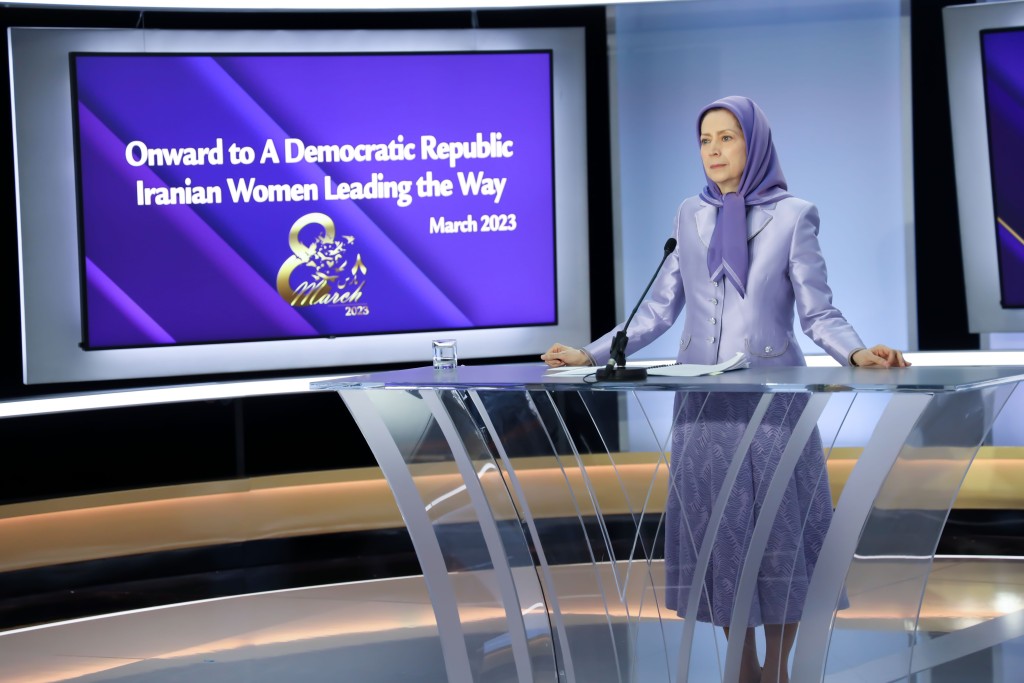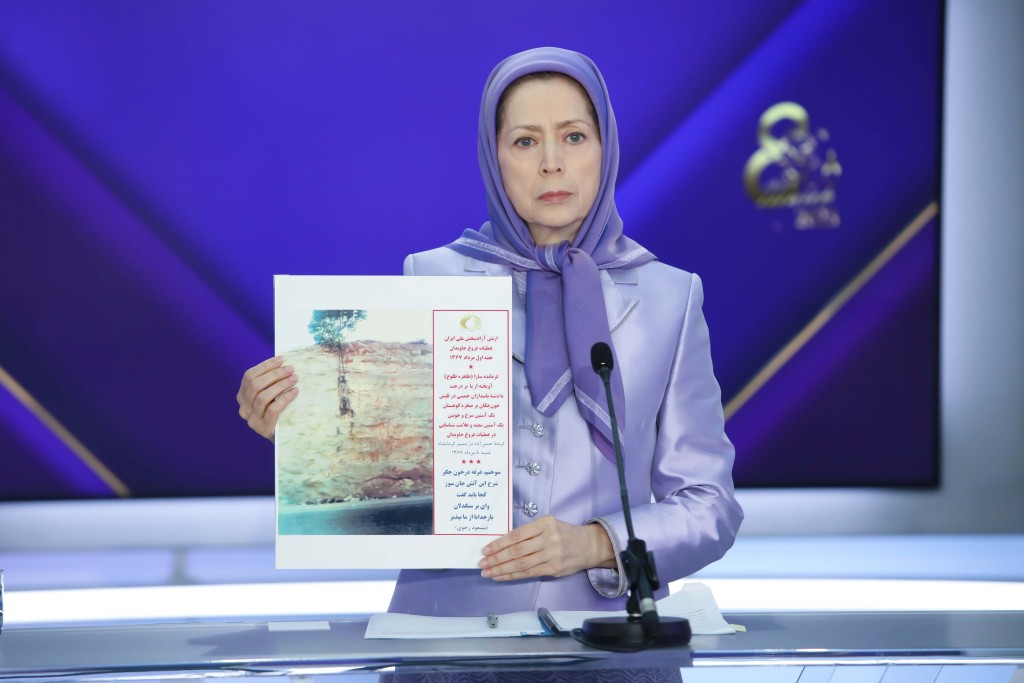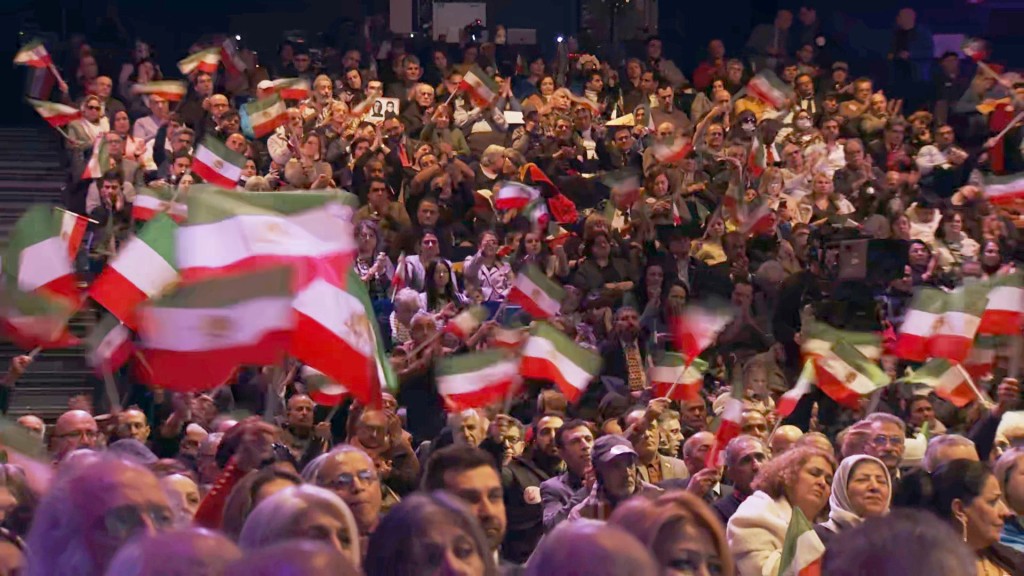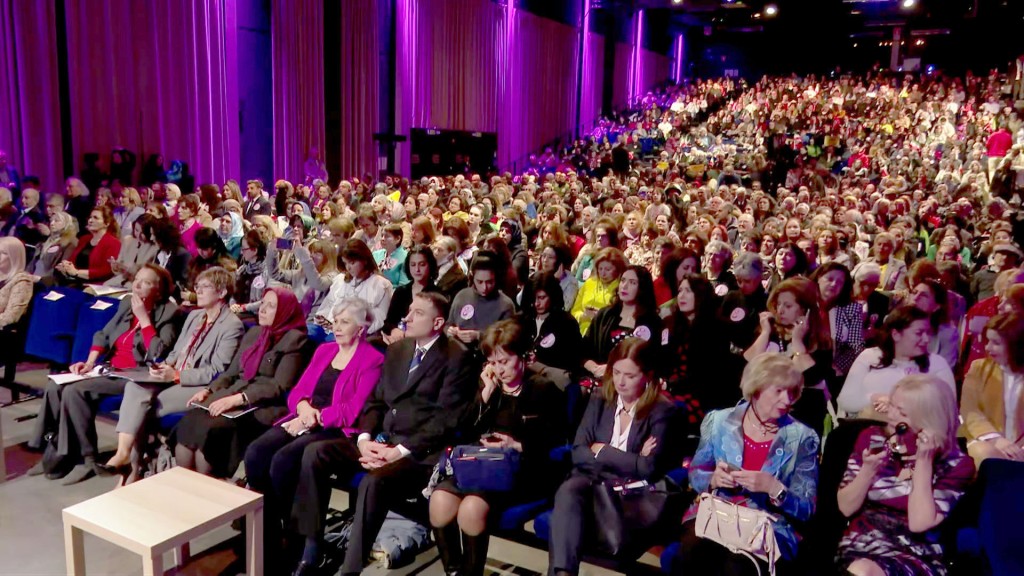Women’s leadership guarantees democracy and equality

Speech at women’s conference on International Women’s Day
As we celebrate International Women’s Day, we send our warmest greetings to the pioneering women commanding the uprising in Iran and to the brave women of the Resistance Units.
We pay tribute to the 83 women who became martyrs during the uprising, from Mahsa Amini to Zarbibi Ismail Zehi in Zahedan.
We extend our infinite greetings to all the courageous women who have sacrificed and continue to sacrifice for Iran’s democratic revolution, enduring immense suffering and torture. These are the women who have been arrested, tortured, and brutally attacked, some losing their sight and even their lives under torture. Our salutes to political prisoners, resistant women in the clerical regime’s prisons and torture chambers.
We also pay tribute to the women leaders who have carried the torch of struggle and resistance against the religious dictatorship for more than four decades, generation after generation. They have been executed or killed under torture in the thousands, yet they are the standard-bearers of Iran’s democratic revolution.
They represent the true spirit of Iranian women, who have risen up as warriors and sacrificed their lives to liberate a nation held captive.
First and foremost, we express our sympathies to the parents of the students affected by the chain poisoning of schoolgirls in various cities and regions of Iran, and we salute their resistance and protest against this criminal regime.
The poisoning of these students has been ongoing for three months, and there is no doubt that it is organized and ordered by the regime. Khamenei’s office is seeking revenge on the girls who played a decisive role in the recent uprising in Iran and is attempting to terrorize them.
Once again, we urge the United Nations, particularly relevant agencies such as UNICEF and the Special Rapporteur on Violence Against Women, to investigate and respond firmly.
Iranian women, Khamenei’s endless nightmare
Dear sisters,
This year’s International Women’s Day has gained a unique radiance and unparalleled credibility, all thanks to the remarkable bravery of Iranian women who have risen up against the oppressive mullahs’ regime. This is what makes this year different from all the past years because it has revealed a great truth: women play a unique role in shaping society’s destiny. A century ago, women fought for the right to vote, and today, they are fighting to change the world, from one of barbarism into a world of freedom, justice, and equality.
A revolution of unprecedented magnitude is underway in Iran, setting a united front of people against the oppressive and misogynistic regime of the mullahs. It is a nationwide uprising that rejects the present and past regimes and is poised to establish a democratic republic, pursuing the same path that the Iranian Resistance and its vanguard women have been paving for over four decades.
Iran’s brave and resilient women, with their unwavering bravery and tireless activism, have become Khamenei’s perpetual nightmare.
In the current uprising, female students have taken the lead in most protests in 204 universities. Furthermore, out of the 1,776 schools where students joined the uprising, 1,186 were girls’ schools.
The uprising and the unparalleled heroism of Iranian women have captivated the attention of the world.
Until yesterday, the role of women executed in Evin and Gohardasht prisons, and in more than 100 of Khomeini’s torture chambers, and the role of women executed in 1981, or the girls who refused to even say their names to their executioners and were shot on June 20 of the same year, has been deliberately concealed.
The role of women who organized themselves for the first time in Iranian history in the units of the Iranian National Liberation Army has been intentionally hidden. The politics of appeasement have left no room to pay attention to the photo of Commander Sara hanging from a tree in the mountains with an IRGC dagger in her heart.
These are the heart-wrenching photos of three women from the People’s Mojahedin who self-immolated: Sedigheh Mojaveri and Neda Hassani, who lost their lives, and Marzieh Babakhani, who survived and underwent dozens of operations thereafter and is present in your gathering today.
After the June 17, 2003, attack on the Iranian Resistance, these women found no other option but to self-immolate to resist the conspiracy of the mullahs in France, especially the so-called reformist mullahs.
If these atrocities against Iranian women had been kept hidden in the darkness of silence and complacency for years, fortunately, the world has now opened its eyes.
Canada’s Minister of Foreign Affairs appropriately stated in a conference with colleagues on October 26 that “We see our humanity in them [Iranian women],” and Le Point described it as “an uprising inspired by women of incredible courage” in its editorial on November 22.
Yes, these flames of freedom and equality that you see, this courage that inspires the world, will be followed by storms. The day will come when the women of Iran will overthrow the religious tyranny of the mullahs.
Iran’s risen women, following the path of pioneering women, have presented a new meaning for life. Nasrin Qaderi, a daughter of the people of Marivan in Kurdistan, was pursuing her PhD in philosophy before being murdered. She wrote, “Don’t make us scared of death, we have lived it.” Several of them also died under torture, including Atefeh Na’ami in Karaj, or Ayda Rostami, the compassionate physician who treated injured protesters in Tehran.

Revolution is necessary for freedom to be achieved
The sacrifices made by these women convey a powerful message – that freedom requires a revolution. A revolution always comes with a price, and those who promise a costless change are only seeking to maintain the status quo.
These women have also exposed and discredited the treacherous policies of pro-regime “reformers.”
In this uprising, Iranian women have not only rejected the mandatory veil but also the compulsory and dictatorial rule of any kind, be it by the Shah or the mullahs.
Reza Shah forced the removal of women’s head coverings, while Khomeini imposed it once again. Thus, the main issue is coercion and dictatorship, where free choice has no place.
But today, a democratic revolution is unfolding in Iran. The defiant girls from Tehran to Zahedan are shouting, “With or without the hijab, onward to the revolution!” They want a democratic republic without a turban or crown, defined by freedom, popular sovereignty, and free elections. They were chanting, retrogression and dictatorship must be eradicated.
The mullahs sought to prevent women from playing a crucial role in overthrowing the religious dictatorship in Iran. For 30 years, we have been saying that the rise of women will ignite the uprising. So, woe to the mullahs, for they will be struck with the fatal blow from where they had never imagined: from women and their unyielding determination to overthrow the mullahs’ misogynistic regime.
What is the crux of the matter?
Dear friends, we all know that women who take on significant responsibilities in the path of struggle often have to pay a price several times higher than men due to historical reasons, in order to fulfill their rightful roles.
How could these women command and bear the weight of leading this fierce struggle to its point of progress and success.
In a nutshell, the answer lies in making a choice – choosing to walk the difficult path of struggle, choosing to sacrifice and pay the price without expecting any rewards, and choosing to fight at all costs. It means choosing to uphold high values, defending the principles and rules of a just battle with an inhuman enemy, and persevering despite demonization, accusations, lies, slanders, and resisting the enemy’s attacks.
For years, even during the current uprising, it was ironic that the regime’s media and Khamenei’s Friday prayer leaders questioned why PMOI women wore the hijab. After all, for 44 years, Khomeini, Khamenei, and the deceitful fundamentalist mullahs have tried to convince Iranian society that the enemy of their rights and freedoms is not the mullahs’ regime, but rather the enemy is United States, Iraq, or Jerusalem. This was despite the fact that the regime continued an eight-year war with Iraq, using the slogan of conquering Jerusalem via Karbala in Iraq.
But we say, the crux of the matter is that the conflict revolves around the Iranian people’s freedom and popular sovereignty. The regime attempts to give its crusade against the Iranian people a religious context and label the PMOI as hypocrites with a distorted Islam. If we let them define the narrative, they will reduce the conflict to a matter of religion and creed, pitting Islam against non-Islam. We reiterate that the central issue is the Iranian people’s popular sovereignty and free elections.
And I repeatedly emphasize that this is the primary conflict that has drawn a line between the PMOI and this regime for 44 years, even during the darkest and most prolonged periods in Iran’s history, and during the country’s most challenging, complicated, painful, and blood-soaked organized resistance. The very Resistance movement that Massoud Rajavi initiated by differentiating between freedom and regression from day one.
Dear friends and sisters,
The mullahs’ questions to PMOI women go beyond the hijab. They continue with a series of other inquiries, such as:
Why don’t you take care of your husbands and children? Why have you devoted yourself to the struggle?
Why do you talk about women’s hegemony?
Why did you dedicate your entire being and energy to resist the regime instead of leading an ordinary life?
The responses to these questions are concise and direct:
To pursue freedom and free choice.
To combat the dictatorship and bring about its downfall.
For the sake of the Iranian people.
For the sake of the women, men, and children of Iran.
So that all Iranian nationalities may enjoy equal rights and freedoms, with autonomy.
And to enable a myriad of possibilities to emerge in a free Iran.

The PMOI’s experience
I have always maintained that our resistance movement, especially 1,000 PMOI women, who comprise the PMOI’s Central Council, has been forged through years of struggle, sacrifice, and determination. We are driven not by a desire for power, but rather to empower the Iranian people, to wrest power from the oppressors who have held it in an authoritarian grip, and to return it to its rightful owners – the people.
This goal is worth any sacrifice, no matter how great, and demands the relinquishing of personal comfort and security. The 1,000 women, who constitute the core of the collective leadership of the Iranian people’s uprising and the strategy of 1,000 Ashrafs, have embraced a selfless ethos, rejecting the mantras of “me first” and “all for myself.”
The practical experience and struggle against both the Shah and the mullahs made this selfless ethos possible, particularly when thousands of PMOI women and girls stood on the frontlines to resist Khomeini and his regime. I remember their courageous parade in Tehran and their tireless campaigning for Massoud Rajavi’s presidential platform that championed freedom. They were imprisoned, tortured, and executed in the thousands, but they refused to be broken and became a shining example of resistance in Iran’s modern history.
In difficult moments when they had to shoulder the burden of heavy responsibilities in positions of hegemony, I witnessed how they reached a vital choice by overcoming doubt and disbelief, and performed their duties.
During the struggle against regression and dictatorship, I witnessed how the ideologies of sexism and self-centeredness were vanquished. The traditional world of jealousy and competition was shattered, giving way to a new era of true sisterhood, mutual support, and cooperation. This is one of the most beautiful moments for me and certainly for all women. I dare to say that they have come together as a collective, driven by passion and determination for significant progress, from overthrowing the oppressive mullahs’ regime to establishing a free, democratic, prosperous, and developed Iran where women have equal participation.
Anyone slightly familiar with this experience knows that walking this path is difficult and involves confronting severe contradictions at every step. However, these women do not compete with one another; instead, they complement and support each other. They recognize that their strength lies in amplifying their power together, rather than eliminating each other. This is the humane and liberating chemistry that every individual needs.
The most significant accomplishment of the Mojahedin women, which has attracted a new generation of revolutionary women over the past four decades, is their ability to create relationships based on empathy instead of narrow-mindedness and jealousy, and their selfless sacrifice for each other knows no limits.
In short, this is what the betrayed trust and wounded emotions of Iranian society need. I have personally witnessed how the path paved by these women has transformed the men within this movement, teaching them to move away from the world of “me first” and competition and embrace the world of brotherhood, solidarity, and support. This has resulted in a new generation of thousands of liberated men.
Revolution’s front versus regression and dictatorship
Fortunately, this liberating conduct has now become widespread among the Resistance Units and rebellious youths and is evident in their uprisings. They follow in the footsteps of their sisters in this resistance, displaying equal measures of courage, aggression, and warriorship. They have learned that by locking arms and collective work they can remain powerful in the face of the enemy. Moreover, they have inspired the Resistance’s supporters who readily accept countless responsibilities in the battle against the regimes of both the mullahs and the Shah in all arenas.
What I said are the tangible realities of the people’s front of revolution and freedom, while the opposing front of reaction and dictatorship utilizes all available powers and resources in their demonization campaigns, with the sole objective of blocking the path for the democratic alternative.
If you have noticed, ever since the masquerade of the reformists and principlists was exposed and Iran’s brave people and youth declared “game over”, there were different attempts to stir up nostalgia for the past regime, claiming that the Iranian people made a mistake in overthrowing the Shah’s dictatorship. They meant to say that this mistake must not be repeated. This argument serves the interests of Khamenei and the ruling mullahs, as it is illogical to suggest that a revolution should be launched to return to the previous reactionary regime.
A suggested alternative is a “velvet revolution,” even if it is not led by a mullah in a velvet turban but rather a velvet Shah! However, the experiences of the past 44 years and the last six months have shown that one cannot overcome the iron-fisted mullahs and their Revolutionary Guards with velvet gloves. This is why it is crucial to recognize the right to self-defense for the people of Iran.
Just looking at the past five years with three major uprisings, namely December 2017-January 2018, November 2019, and September 2022 until today, it is clear that without the Resistance Units, the situation would have been entirely different. Therefore, we must move forward and focus on the future. Stagnation in the present or a return to the past is neither logical nor practical.
Therefore, the central issue is the fate of the Iranian people’s freedom and the destiny: will they rise up to overthrow the regime or continue with the status quo? Will they undergo a revolution or regression? Will they emerge victorious, or will their uprising be betrayed and slaughtered by the Shah and the mullahs? Indeed, which one?
The correct answer is unequivocally the one that will be realized in the Iranian people’s uprising, with decisive participation of women. The victory for a free and democratic republic is the only way forward for Iran. Yes, Iran’s democratic revolution will triumph.
Friends,
The restoration of the rights of the oppressed is at the heart of the necessity for democracy, and at the forefront of this is the freedom and rights of Iranian women. Freedom and equality are the fundamental building blocks of fair and just societies. They represent the key to unlocking the true potential for the development of tomorrow’s Iran. Almost 36 years ago, the National Council of Resistance (NCRI) unanimously adopted a plan outlining the rights and freedoms of women. Thirteen years ago, in March 2010, I presented the Iranian Resistance’s vision for advancing women’s rights during a meeting at the European Parliament titled “Women Pioneer Democratic Change in Iran.”

The Plan on Women’s Rights and Freedoms
Now, once again, I would like to recall the principles, emphasis, and summary of the most important articles that will guide our future actions. Our compatriots inside Iran must be aware of them.
These principles, rights, and freedoms are not just for the emancipation of women but for the historical liberation of all Iranian men and women.
First, I would like to state the principles:
The first principle is the abolition and elimination of all forms of oppression, coercion, and discrimination and imposed by the reactionary regime of the mullahs’ reactionary regime and their Sharia law and adhering to all freedoms and rights of women as stipulated in the Universal Declaration of Human Rights, the Convention on the Elimination of All Forms of Discrimination against Women and the Declaration on the Elimination of Violence Against Women approved by the United Nations General Assembly in December 1993.
The second principle emphasizes the full equality of social, political, cultural, and economic rights between men and women.
The third principle is ensuring the complete provision of women’s rights in the country, without regard to any unequal and discriminatory practices or limitations, and rejecting any perception that views women as commodities.
And the most important articles on women’s rights and freedoms in the free Iran of tomorrow:
1. The right to elect and be elected in all elections and the right to suffrage in all referendums.
2. The right to employment and free choice of profession, and the right to hold any public or government position, office, or profession, including the presidency (as well as political leadership) or judgeship in all judicial institutions.
3. The right to free political and social activity, social intercourse, and travel without the permission of another person.
4. The right to freely choose their clothing and attire.
5. The right to use, without discrimination, all instructional, educational, athletic, and artistic resources; and the right to participate in all athletic competitions and artistic activities.
6. Recognition of women’s associations and support for their voluntary formation throughout the country; consideration of special privileges in various social, administrative, cultural, and particularly educational fields in order to abolish inequality and the dual oppression of women.
7. Equal pay for equal work; prohibition of discrimination in hiring and during employment; equal access to various privileges such as vacations, retirement benefits, and disability compensations; enjoyment of child and marital benefits and unemployment insurance; the right to salary and special accommodations during pregnancy, childbirth, and infant care.
8. Absolute freedom in the choice of spouse and marriage, which can take place only with the consent of both sides and registered with a legal authority; Marriage before attainment of the legal age is prohibited. In family life, any form of compulsion or coercion of the wife is prohibited.
9. Same right to divorce as men; divorce proceedings should be handed by qualified judicial authorities; child custody and support as well as financial settlements will be determined by the verdict for divorce.
10. Support for widowed and divorced women and for children in their custody; care will be provided through the National Social Welfare System.
11. Elimination of legal inequalities regarding testimony, guardianship, custody, and inheritance. Polygamy is prohibited.
12. Prohibition of all forms of sexual exploitation of women under any pretext and abrogation of all customs, laws, and provisions allowing the father, mother, guardian, or another to give way a girl or a woman, for marriage or other reasons.
Dear Friends,
It is correct when they say women’s rights are human rights, and I firmly believe that women’s leadership is the guarantee for democracy and equality. Without providing opportunities for women to participate in political leadership, any progress made towards gender equality is vulnerable to regression.
Today, Iranian women, with their leadership and alongside Iranian men, are at the forefront of defeating religious dictatorship and securing freedom, democracy, and equality for tomorrow.
The uprising in Iran, led by women, has proved this truth. The uprising, which is blazing more fiercely than ever, will make it shine brighter than ever before and bring the message of victory and triumph.
How beautiful it is that, like dawn, we bring the tidings of triumph,
With a red rose, a light-filled bloom, from the garden of dawn,
How beautiful it is, like the radiant sun, to scatter brilliance and shine,
To herald the world from skies ablaze with radiance newly born.
Victory is yours!

- Tags: Iran protests, Iran's women, mullahs' regime, victim, Women

